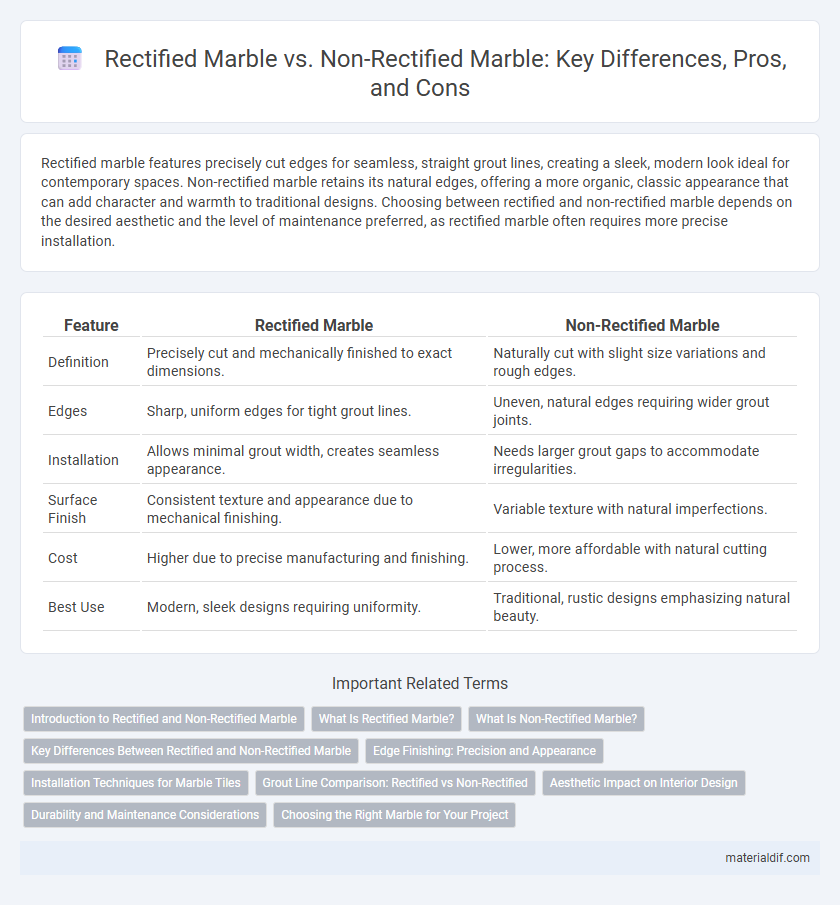Rectified marble features precisely cut edges for seamless, straight grout lines, creating a sleek, modern look ideal for contemporary spaces. Non-rectified marble retains its natural edges, offering a more organic, classic appearance that can add character and warmth to traditional designs. Choosing between rectified and non-rectified marble depends on the desired aesthetic and the level of maintenance preferred, as rectified marble often requires more precise installation.
Table of Comparison
| Feature | Rectified Marble | Non-Rectified Marble |
|---|---|---|
| Definition | Precisely cut and mechanically finished to exact dimensions. | Naturally cut with slight size variations and rough edges. |
| Edges | Sharp, uniform edges for tight grout lines. | Uneven, natural edges requiring wider grout joints. |
| Installation | Allows minimal grout width, creates seamless appearance. | Needs larger grout gaps to accommodate irregularities. |
| Surface Finish | Consistent texture and appearance due to mechanical finishing. | Variable texture with natural imperfections. |
| Cost | Higher due to precise manufacturing and finishing. | Lower, more affordable with natural cutting process. |
| Best Use | Modern, sleek designs requiring uniformity. | Traditional, rustic designs emphasizing natural beauty. |
Introduction to Rectified and Non-Rectified Marble
Rectified marble features precisely cut edges achieved through a mechanical process, resulting in uniform slabs with minimal grout lines, ideal for sleek, modern designs. Non-rectified marble retains its natural, uneven edges, providing a more organic and traditional aesthetic with wider grout joints that accommodate natural variations. The choice between rectified and non-rectified marble impacts installation methods, final appearance, and maintenance requirements.
What Is Rectified Marble?
Rectified marble undergoes a precise mechanical grinding and cutting process to achieve uniform edges and exact dimensions, contrasting with non-rectified marble's natural, slightly irregular edges. This process allows rectified marble tiles to be installed with minimal grout lines, creating a seamless and modern aesthetic. Rectified marble is ideal for contemporary designs requiring a sleek, smooth surface and tight layout precision.
What Is Non-Rectified Marble?
Non-rectified marble features natural, uneven edges and requires grout lines that accommodate its slight size variations, emphasizing its organic and classic aesthetic. This type of marble is polished but not mechanically ground to precise dimensions, resulting in a softer, more traditional look compared to rectified marble. Ideal for designs seeking authenticity and subtle texture, non-rectified marble offers versatility and warmth in flooring and wall applications.
Key Differences Between Rectified and Non-Rectified Marble
Rectified marble features precisely cut edges that allow for minimal grout lines, creating a seamless and modern appearance, whereas non-rectified marble has natural, uneven edges requiring wider grout spacing for better accommodation. Rectification involves a mechanical grinding process enhancing uniformity and enabling tighter installation, while non-rectified marble retains its original, raw edge finish, offering a more rustic and traditional look. Durability and maintenance are comparable, but rectified marble often demands more precise installation and higher initial costs due to its precision cutting.
Edge Finishing: Precision and Appearance
Rectified marble features edges that are mechanically ground to achieve a uniform, precise 90-degree angle, enhancing the tile's seamless appearance and enabling minimal grout lines. Non-rectified marble retains natural, slightly rounded edges, which offer a softer aesthetic but require wider grout spacing to accommodate irregularities. The precision of rectified edges improves installation accuracy and yields a cleaner, more modern finish compared to the traditional look of non-rectified marble.
Installation Techniques for Marble Tiles
Rectified marble tiles feature precisely cut edges that allow for minimal grout lines, requiring careful alignment during installation to achieve a seamless look. Non-rectified marble tiles have natural, slightly uneven edges, necessitating wider grout joints to accommodate size variations and prevent cracking. Professional installers must adjust techniques and use appropriate spacers to ensure stability and aesthetics based on the tile type.
Grout Line Comparison: Rectified vs Non-Rectified
Rectified marble features precisely cut edges, resulting in minimal grout lines typically around 1/16 inch, creating a seamless and modern appearance with less visible grout. Non-rectified marble has natural, uneven edges requiring wider grout lines of about 1/8 inch or more, which accentuates the individual tiles and offers a more traditional look. The choice between rectified and non-rectified grout lines impacts both aesthetic appeal and maintenance, with narrower grout lines on rectified marble being easier to clean and less prone to accumulating dirt.
Aesthetic Impact on Interior Design
Rectified marble provides a sleek, seamless look in interior design due to its precise, machine-cut edges that allow for minimal grout lines, enhancing modern and minimalist aesthetics. Non-rectified marble features natural, slightly uneven edges that create a more organic and traditional appeal, adding character and texture to spaces. The choice between rectified and non-rectified marble significantly influences the visual flow and style cohesion in residential and commercial interiors.
Durability and Maintenance Considerations
Rectified marble features precisely cut edges that allow for minimal grout lines, enhancing durability by reducing exposure to dirt and moisture compared to non-rectified marble with uneven edges. The smooth, uniform surface of rectified marble simplifies maintenance by making it easier to clean and less prone to chipping or cracking. Non-rectified marble requires more frequent sealing and careful cleaning to preserve its surface integrity due to its natural, unpolished edges and texture.
Choosing the Right Marble for Your Project
Rectified marble features precisely cut edges for a uniform, seamless appearance ideal for modern, minimalistic designs, while non-rectified marble maintains its natural, slightly rounded edges, lending a more traditional and organic feel. Selecting the right marble depends on the desired aesthetic, installation method, and maintenance preferences, with rectified marble requiring exact grout lines and non-rectified allowing for wider spacing. Considerations include project style, durability needs, and budget constraints to ensure the marble choice complements both function and visual appeal effectively.
Rectified Marble vs Non-Rectified Marble Infographic

 materialdif.com
materialdif.com